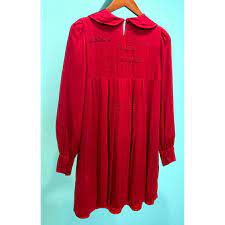According to the National Crime Information Centre, almost 6,000 Native American and Alaskan Native girls and women were reported to be missing in 2016.
No More Stolen Sisters is an exhibition by the Walker’s Point Centre for Arts in Milwaukee to honour and bring attention to the women who are still missing or who’s murders remain unsolved. Curated by Valaria Tatera and Teresa F. Faris, the show spans across mediums and techniques, hosting Indigenous artists from across the United States and its territories.
“The intention is to bring awareness to the crisis and hold space for the MMIWG2S and their families. I think it’s essential that we understand that the connection between the commodification and exploitation of Indigenous lands leads to the commodification and exploitation of Indigenous people,” Tatera said to US news.


The Spider Silk Dress by Chloe Allyn uses silk which is “revered but easily damaged”. The beaded words on the dress are clumsy and heavy against the delicate fabric, damaging the dress. The red is bright and the dress is painfully ordinary until one inspects it closely. The embroidered words are taken from an edited poem featured above. Per the artist: “Imagine you are a modern Indigenous woman, the scare of those being lost all around you, decorate you, and you carry them along.”
“A National Institute of Justice study found that four in five American Indian and Alaska Native women have experienced violence in their lifetime, so that’s about 84%,” says Tatera. “And from that 84%, half of those women have experienced sexual violence.”
Baggage features a woman in Indigenous garb whose face is replaced by a barcode. Women and Indigenous communities can often be treated like commodities, which the artist underscores by replacing the woman’s face with a barcode. The piece also highlights the introduction of materialism into the First Nations culture.
Justicia, 2021 is a silkscreen print on Sekishu paper made by Andrea Narno. The pedicularis, a plant native to South America, is featured in pale green in the background of the print. The artwork features a phrase that translates to “until I find them” written in the artist's native Spanish. The piece highlights the rates of missing people in Mexico, encouraging viewers to keep those who are missing in memory and to keep fighting to find them.
Lorena Lazard’s work draws attention to the femicide epidemic in Mexico, where 6 in 10 women have experienced instances of violence, with 40% of women experiencing sexual assault. The necklace is created out of brass rings with thread and polymer clay women that have images transferred onto them. Through Not One More Necklaces, Lazard honours the victims of femicides, those whose memories are carried with their families who take them with them, hoping that no more chains will be added.
Valaria Tatera’s piece, Justice, 2020, grows over time as the artist adds new ribbons as new data on the missing and murdered women become available, making it a, “living installation”. These 500 red ribbons are stamped with the word “justice”, each one representing a missing woman and the failure to bring her and her family justice.
Through every artwork featured in the exhibition, No More Stolen Sisters honours the United Nations Sustainable Development Goals for Gender Equality and Peace, Justice and Strong Institutions and Strong Institutions by highlighting the injustices and trauma’s against Indigenious women and calling for action and for their protection.
The course catalogue or the virtual reality exhibition can be viewed here.
